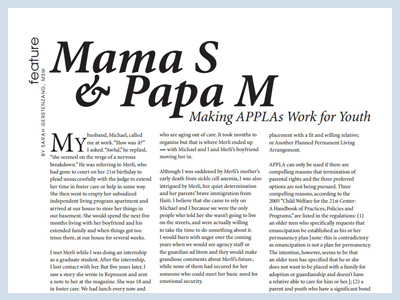Another Planned Permanent Living Arrangement
by Sarah Gerstenzang, MSW
Fostering Families TOday May/June 2010
When a child is removed from his or her family and comes into foster care and it isn’t safe to return home, it is the legal and moral obligation of the caseworker, as a government agent, to make sure that the child leaves care connected to a responsible adult. Federal law — the Adoption and Safe Families Act of 1997 — has set a list of options to be considered and pursued in order of most to least secure: adoption; legal guardianship; placement with a fit and willing relative; or Another Planned Permanent Living Arrangement.
APPLA can only be used if there are compelling reasons that termination of parental rights and the three preferred options are not being pursued.
Three compelling reasons, according to the 2005 “Child Welfare for the 21st Center: A Handbook of Practices, Policies and Programs,” are listed in the regulations:
- an older teen who specifically requests that emancipation be established as his or her permanency plan [note: this is contradictory as emancipation is not a plan for permanency. The intention, however, seems to be that an older teen has specified that he or she does not want to be placed with a family for adoption or guardianship and doesn’t have a relative able to care for him or her.];
- a parent and youth who have a significant bond but the parent is unable to care for the youth because of an emotional or physical disability and the youth’s foster parents have committed to raising the youth to the age of majority and to facilitate visitation with the disabled parent; or
- an American Indian tribe has identified another planned permanent living arrangement for youth.
To summarize, APPLA can and should be used if the three preferred alternatives are not an option, whether or not parental rights have been terminated. And this is true even if a youth is living in an institutional setting — as long as a caring, committed adult is involved in planning for and with the youth. Before this legislation and since, outside the child welfare system, adults support youth in care or who are leaving care. In addition to it now being mandatory to have, at a minimum, a caring, committed adult for each child, best practice also dictates inviting the adults from the shadows to the table so that relationships between the adults and youth are strengthened.

